
(image credit: giggul371)
Shavuot is best known as the holiday which commemorates the bestowal of the Ten Commandments at Mount Sinai. It is also the celebration of the harvest of the Bikkurim, the first fruits of the year. Pomegranates and figs may come most easily to mind, but wheat is another of the Shiv’at Haminim, the seven species, and probably the one that we eat most often. And so at the end of Shavuot this year I found myself inspired, and decided to try my hand at celebrating the harvest with a bit of baking.
Now, bread-making can be a rather scary prospect, even for the experienced baker. I’ve knocked out meringues and madeleines fearlessly, brûléed crème without breaking a sweat and rolled tart crusts galore. On one memorable occasion I even made a wedding cake. But yeast? Yeast has always sent me running for the proverbial hills. However, several recent spikes in the cost of bread, a growing desire to understand exactly what goes into producing the food I often take for granted, and the aforementioned harvest festival proved to be an irresistible combination – a baker of bread I would become.
First, a bit of research seemed in order. The literature on the craft of baking bread is extensive, almost overwhelmingly so. I decided to start with the basics… Flour.

A grain of wheat has three constituents: the endosperm (starch), the germ (protein, mostly gluten), and the bran (fiber). White flour is made just from the endosperm; whole wheat flour is made from the entire grain, and thus is more nutritious than white flour: it contains protein and fiber that white flour lacks. In good green spirit, I wanted to make 100% whole wheat bread.
Wheat varieties are also classified as hard or soft: hard wheat has a high gluten content, whereas soft wheat has relatively little gluten. Bread flour and hard flour are synonymous: gluten is the substance in wheat which makes it toothsome and chewy, which is generally what we’re after in bread. (By contrast, pastry and cake flours are soft; their lower gluten content makes them yield results that are light rather than chewy, which is why they are suited for cakes and cookies.)
The major risk in making a loaf that is 100% whole wheat is that it will be too dense. To avoid the dreaded boulder effect, I decided to add a bit of extra gluten to my batter – you can buy gluten flour (which is generally about 80% gluten by weight) at health food stores, and the extra chewiness it provides helps counteract the tendency of whole wheat bread to be heavy.
And thus, with a bit more legwork (which I shall spare you), and with the help of bakers far more experienced than I, fresh, homemade bread finally made its way out of my oven. It was, despite my fears, really quite straightforward, and immensely, deeply satisfying.
Organic Whole Wheat Bread recipe:
1 1/2 cups (350 grams) lukewarm water
2 tbsp honey
1 tablespoon active dry yeast
3 1/2 cups (430 grams) hard whole wheat flour, plus about another 1/2 cup for dusting
2 tbsp gluten flour
1 teaspoon salt
1 tbsp vegetable oil
In a medium bowl combine 1/2 cup of the water, the honey and the yeast. Set somewhere warm (room temperature this time of year is just fine) until the yeast is bubbly, about 15 minutes.
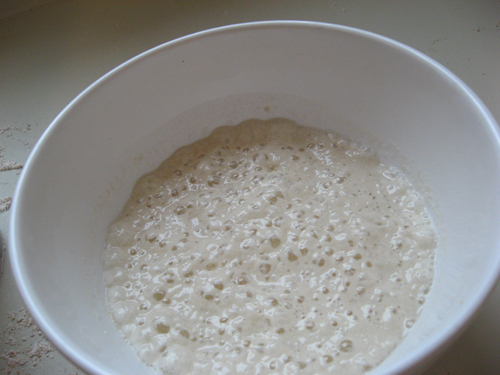
In a large bowl stir together the flour, gluten flour and salt. Pour in the yeast mixture and the remaining water. Stir together with a big wooden spoon to blend. If necessary, add in a bit more flour, until the dough just barely holds in a loose ball — it should still be quite sticky at this stage.
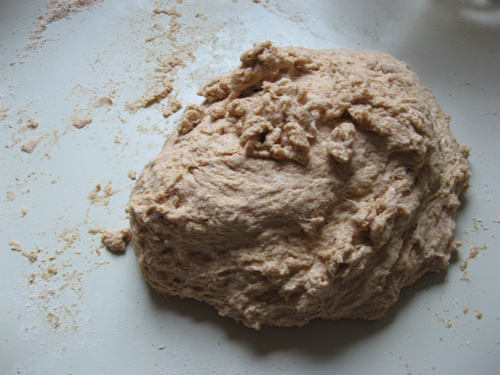
Turn dough out onto a floured work surface, dust the top of the dough with flour and begin to knead. Dust work surface and dough with flour periodically, and continue to knead until dough becomes smooth and comes cleanly away from your hands, about 10 minutes. (When it is fully kneaded, the dough will be elastic and you’ll be able to handle it quite easily.)

Using half the oil, grease a large bowl. Place dough in the bowl and turn to coat with oil. Cover with a damp kitchen towel and set somewhere warm to rise, 2 hours.
Use the remaining oil to grease a loaf pan. Gently deflate the dough, form into a loaf, and place in the prepared pan. Cover again with the dish towel and set to rise a second time, 1 hour.
Preheat oven to 350F; position a baking rack in the center of the oven. Bake bread for about 40 minutes, until crust is golden brown and the loaf sounds hollow when thumped on the bottom. Cool on a wire rack before slicing.
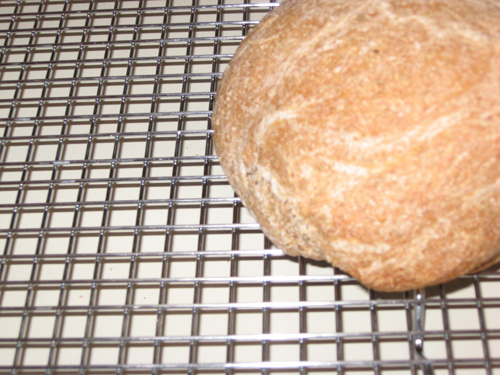
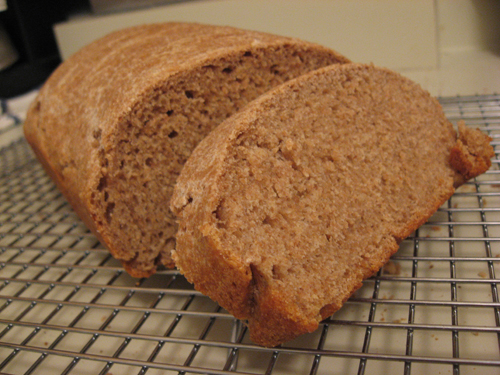



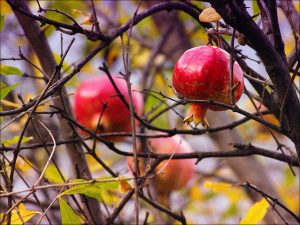
might appear as a dumb question but what is the difference between whole wheat flour and whole meal flour?
Dear Brother Arnold,
This year is shmitta in Israel so the land lays fallow. Fruits from trees belong to everybody. Hamultal lives in Canada, where there are no prohibitions on the land.
-R
According to the Rabbis, at http://www.star-k.org/kashrus/kk-yoshon-prepchodosh.htm they don’t use spring wheat until the next year.
Brother Arnold
Where do you find gluten flour in Tel Aviv? I have looked for it in a few health food shops, but no luck! I use it for seitan and would be happy to know where to find it the Tel Aviv area
Wow, looks delicious!! Using yeast would send me running for the proverbial hills too, though. I started making bread a couple months ago, but I’ve been making an Irish soda bread based on Alice Water’s recipe that doesn’t require yeast (and is super easy to make). I add things like sundried tomatoes, flax seed and sunflower seeds to keep it interesting. Worth a try: http://planetgreen.discovery.com/food-health/make-this-easy-soda-bread.html